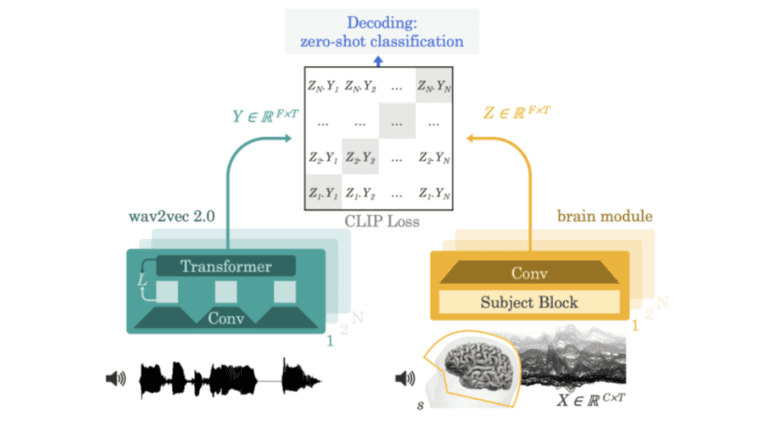TL;DR:
- Meta AI introduces a machine learning model using contrastive learning to decode speech from non-invasive brain recordings.
- This innovation builds upon successes with invasive devices, offering the potential for language decoding without invasiveness.
- The model boasts an impressive accuracy rate of up to 41% in speech segment identification and 80% in the best-performing participants.
- Ethical approvals for healthy adult volunteers’ datasets have been secured.
- Future research will explore factors affecting decoding accuracy, linguistic attributes, and real-time speech perception scenarios.
Main AI News:
In the ever-evolving landscape of healthcare and neuroscience, the quest to decode speech from brain activity has been a longstanding ambition. Recent strides in the field have been made through invasive devices, with deep-learning algorithms effectively deciphering fundamental linguistic elements. However, the translation of these achievements to the realm of natural speech and non-invasive brain recordings has remained an elusive goal – until now.
Meta’s team of researchers has introduced a groundbreaking machine learning model that harnesses the power of contrastive learning to decode the intricate tapestry of perceived speech from non-invasive brain recordings. This innovative approach amalgamates data from four distinct datasets, culminating in a significant leap forward for the field. The results obtained hold the promise of unlocking language decoding from brain activity without resorting to invasive procedures, offering profound implications for both healthcare and neuroscience.
Expanding Horizons: Decoding Speech with Non-Invasive Precision
Building upon the notable successes achieved with invasive devices in decoding linguistic elements, Meta’s researchers have charted a path toward a new frontier. Their pioneering method introduces a contrastive learning model, meticulously trained to decode self-supervised speech representations. What sets this approach apart is its strikingly extensive vocabulary compared to invasive counterparts, opening up exciting prospects for applications in speech production. Importantly, all endeavors have been ethically grounded, with requisite approvals obtained for datasets sourced from healthy adult volunteers engaged in passive listening.
Navigating the Challenges of Non-Invasive Speech Decoding
Deciphering speech from non-invasive brain recordings is undeniably a formidable challenge in healthcare and neuroscience. While the field of invasive devices has made commendable progress, the transition to natural speech has been characterized by hurdles. Meta’s approach introduces a neural decoding task that unravels the complexities of perceived speech from non-invasive brain recordings. The model’s training and evaluation process encompasses a diverse array of data sourced from four public datasets and features the participation of 175 volunteers who were recorded via MEG or EEG while engrossed in stories.
The architecture of the model adopts a common convolutional framework, meticulously honed through the simultaneous training on multiple participants. Comparative analyses with traditional baselines underscore the remarkable influence of contrastive objective and pretrained speech representations. Additionally, the model’s predictions rely primarily on lexical and contextual semantic representations, marking a significant stride in the quest for non-invasive speech decoding.
Unlocking the Potential: Promising Results and Future Prospects
The journey of Meta’s researchers has yielded a striking contrastive learning-based model for decoding perceived speech from non-invasive brain recordings. This model has demonstrated remarkable results, boasting an average accuracy rate of up to 41% in speech segment identification and soaring to an impressive 80% accuracy in the most proficient participants.
Comparison with traditional baselines reaffirms the importance of contrastive objectives, pretrained speech representations, and the shared convolutional architecture in elevating decoding accuracy. Crucially, the model’s predictions lean heavily on lexical and contextual semantics, illuminating a pathway toward non-invasive language decoding in the realms of healthcare and neuroscience.
Charting the Path Forward
While Meta’s achievements are undeniably groundbreaking, there remains a roadmap for future research. Understanding the factors contributing to decoding accuracy variations among participants and datasets is an essential endeavor. Delving into the model’s performance in addressing more intricate linguistic attributes and real-time speech perception scenarios is crucial. Assessing its adaptability to diverse brain recording or imaging techniques is a pressing concern. Lastly, exploring its capacity to capture prosody and phonetic features promises to offer a comprehensive insight into the fascinating world of speech decoding.
Conclusion:
Meta AI’s breakthrough in non-invasive speech decoding signifies a significant advancement for the healthcare and neuroscience markets. This technology has the potential to revolutionize the way we decode language from brain activity, eliminating the need for invasive procedures and opening up new possibilities for research and applications in these fields. It’s a promising development that demands attention from investors and stakeholders looking to invest in cutting-edge advancements in healthcare and neuroscience.

